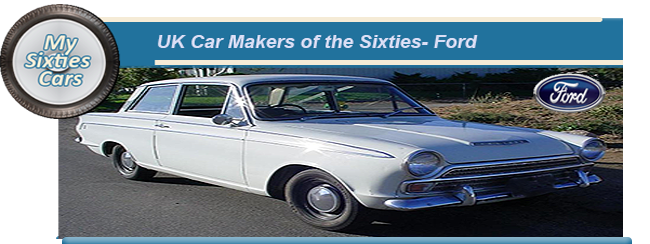
The earliest UK Fords were actually produced in the massive Ford plants in Detroit, Michigan and shipped in kit form to the new Ford plant based Trafford Park, near Manchester where they were assembled.
Having successfully tested the waters, Ford UK soon decided that the time was right to move into production, opening a huge manufacturing unit in Dagenham, Essex for the purpose.
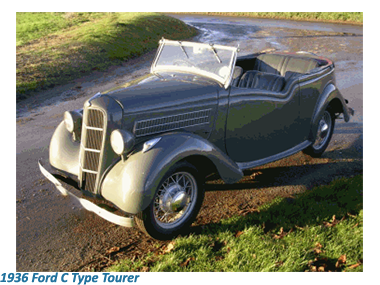 The Dagenham plant remained Ford-UK's only private-car assembly plant until 1963. From that point, a second assembly plant, at Halewood (on the outskirts of Liverpool), was added to cope with demand.
The Dagenham plant remained Ford-UK's only private-car assembly plant until 1963. From that point, a second assembly plant, at Halewood (on the outskirts of Liverpool), was added to cope with demand.
For some years after the end of World War Two, Ford seemed reluctant to update their designs, and for most of the Fifties, the company plodded along with a range of cars with a decidedly pre-war look, the Anglia / Prefect, and the V8 engined Pilot.
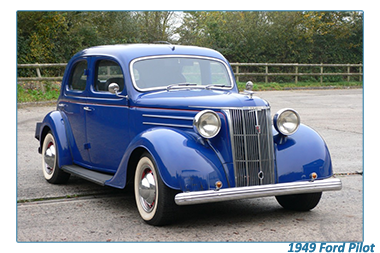 Eventually, Ford UK began to shake off the cobwebs and launched their first all-new post-war model range - the Consul/Zephyr family of 1950.
Eventually, Ford UK began to shake off the cobwebs and launched their first all-new post-war model range - the Consul/Zephyr family of 1950.
During the Sixties, Ford emerged as a manufacturer of family cars with very well-developed sporting qualities, skilfully contriving to combine these characteristics with the possibly more saleable attributes of reliability and value for money.
By the start of the decade, Ford began to gradually move up a gear with the launch of the more advanced 105E Anglia range while at the other end of the scale were the larger four-/five-seat Mark II Consul, Zephyr and Zephyr Zodiac saloon, estate and convertible series.
Between these two clear-cut types, the small economy saloon and the larger, faster, more expensive and better-appointed Ford UK had nothing to offer. A shortcoming that the set about overcoming with tremendous success throughout the Sixties.
In August 1960 the attractive estate car version of the Anglia first rolled off the production lines, to be announced in October.
With its upward-opening rear door, the tail sloping to a convex V-shape at waist level, the more aerodynamic shape of this estate gave it a more streamlined appearance than the saloon.
![]()
Standard and De Luxe versions of the Anglia were offered, the former with a painted, metal-framed wooden floor, and the latter with a laid lino floor, alloy rubbing strips, a lockable glovebox, opening rear quarter-lights and a full-width radiator grille.
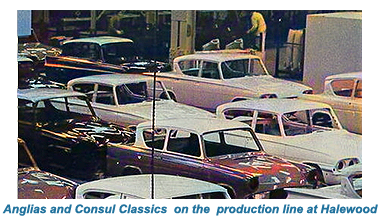 In June 1961 Ford UK took the first of two steps towards producing a car to fill the gap between the small saloon car family and their larger brethren with the launch of the Ford Consul Classic.
In June 1961 Ford UK took the first of two steps towards producing a car to fill the gap between the small saloon car family and their larger brethren with the launch of the Ford Consul Classic.
The Classic has often been looked upon as a rather unfortunate styling example, its reverse-angle rear screen inherited from the Anglia looking rather out of place on the larger car, and its large tail fins apparently never quite 'clicking' with the public.
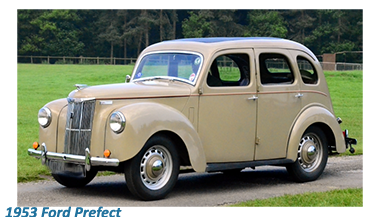 Twin headlamps were fitted side-by-side in broad wings; with circular sidelights mounted outboard, while twin rear lights were provided on either side.
Twin headlamps were fitted side-by-side in broad wings; with circular sidelights mounted outboard, while twin rear lights were provided on either side.
A special two-seat two-door version also appeared, named the Capri Coupe. This was styled very closely after the Classic below the waistline but had a forward sloping rear screen in what would later be termed 'fastback' styling, although a separate horizontal boot-lid was retained.
Production figures for both the Classic and Capri models were modest for Ford, totalling 130,000 units.
Where the Classic and Capri had failed to attract the public with their 'American' styling and rather cheap and nasty appearance, the opposite was to be true of the company's second line of attack in this medium saloon car range - the Cortina.
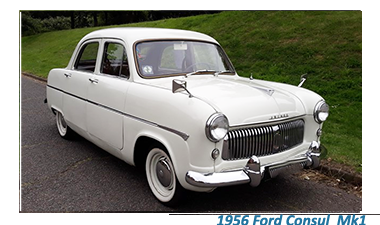 The new Cortina was as practical as it was good looking, with two doors, and powered by an 1198-cc engine mated to an all-synchromesh four-speed gearbox. Some £12 million and four years' work had gone into the car's development.
The new Cortina was as practical as it was good looking, with two doors, and powered by an 1198-cc engine mated to an all-synchromesh four-speed gearbox. Some £12 million and four years' work had gone into the car's development.
The standard Cortina models had black Vinyl fascia-lining in place of the painted metal used previously, Aeroflow controls were simplified with twist regulators set into the vents themselves, carpeting replaced rubber floor mats, and '1300' lettering appeared on the tail of the 3034E cars.
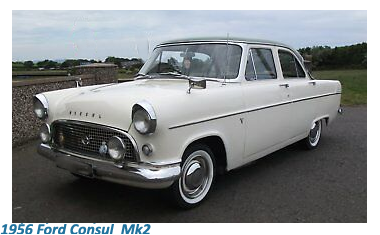 The 3036E 1600 Crossflow engine replaced the 1500 unit, in similar body shells; reclining front seats were optional on both the 1300 and 1600 variants and worthwhile in that they made possible much-improved driving positions.
The 3036E 1600 Crossflow engine replaced the 1500 unit, in similar body shells; reclining front seats were optional on both the 1300 and 1600 variants and worthwhile in that they made possible much-improved driving positions.
At the same time a new model, the Cortina 1600E, was announced.
This vehicle, cast in the 'executive' mould with normally optional equipment fitted as standard, was based on the new four-door shell, with GT mechanical parts and lowered Lotus-type suspension.
With a Weber twin-choke carburettor, the GT engine produced 88 bhp. Standard equipment on this attractive motor-car included a wooden fascia and door cappings, wide-rim sculptured road wheels, an aluminium leather-rimmed steering wheel, reversing lamps and radial ply tires. Over 1,600,000 of all versions of the Ford Cortina were produced between September 1962 and Spring 1969.
In October 1963 a slightly larger, somewhat less handsome five-seater had been produced to provide yet another medium stage between the small and large saloons - the Corsair.
![]()
With a tapering nose line and otherwise angular shape, the 120E Corsair was cast very much in the conventional Cortina mould.
Macpherson strut and an elliptical leaf-spring suspended live rear axle were retained, with disc brakes at the front, column gear-change and a deep bench-type front seat.
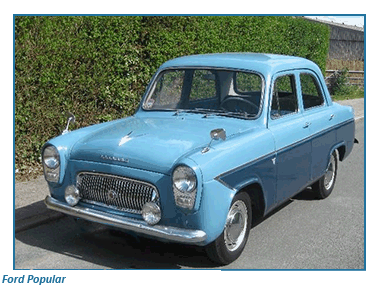 The 1498-cc engine was used, and a 120GT series version was also introduced, being offered in two- and four-door form with bucket front seats and a central gear-change as standard, although in September 1965 Ford of Dagenham followed the lead of Ford Germany and introduced a V4 engine for use in the Corsair range.
The 1498-cc engine was used, and a 120GT series version was also introduced, being offered in two- and four-door form with bucket front seats and a central gear-change as standard, although in September 1965 Ford of Dagenham followed the lead of Ford Germany and introduced a V4 engine for use in the Corsair range.
By the mid-sixties the Ford range had evolved into one of the most progressive in the country, offering small and large cars, with several intermediate stages of luxury, performance, and price: the 105E Anglia, the Cortinas, Corsairs and, at the top of the list, the Zephyrs and Zodiacs.
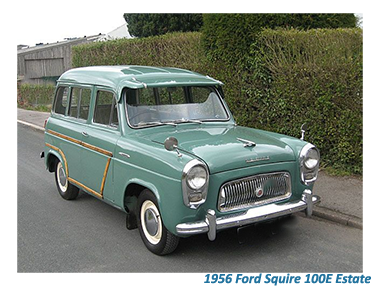 The Mark II versions of the larger cars were replaced by the Mark III in April 1962 and immediately impressed with their straightforward good looks, broad grille design and practical tail fins, which allowed the tail to be sighted easily when reversing.
The Mark II versions of the larger cars were replaced by the Mark III in April 1962 and immediately impressed with their straightforward good looks, broad grille design and practical tail fins, which allowed the tail to be sighted easily when reversing.
In early 1968 Ford announced that they would be replacing Anglia range (which had been a tremendous success selling well over 1,250,000 units ) in favour of the new Escort saloons in November 1967.
So polished were Ford during the Sixties that they had begun production of the new model the previous November, and immediately upon its announcement, the new Escort became generally available in large numbers: a move that was so typical of Ford's close attention to promoting an image of quick and efficient customer service.
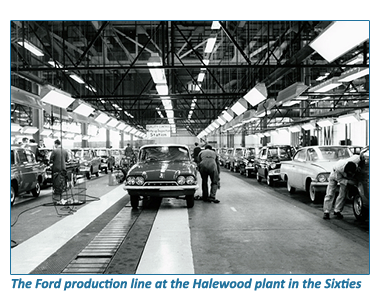 The new model was longer, lower and broader than the Anglia, with the more interior room (although rear-seat headroom was limited, as was a tail vision when reversing).
The new model was longer, lower and broader than the Anglia, with the more interior room (although rear-seat headroom was limited, as was a tail vision when reversing).
The suspension was modified to include rack-and-pinion steering, for the first time on a Ford, and a link system took over from the anti-roll bar in locating the bottom ends of the front struts.
Estate car versions with the 1100 and 1300 engines soon appeared, and an optional automatic transmission was soon available.
The Escort was not Ford’s last new model of the Sixties.
In January of 1969 Ford Europe Inc, a combined operation between Ford of Dagenham and Ford Germany announced that they had branched out into a previously uncharted area, the sports car market with the launch of the Ford Capri.
The Capri was a `universal' motor-car, capable of accepting all engines in the two Ford ranges, and also offered with three optional trim packs, the 'X,' and 'R.'
With its Escort-sized cabin and suspension and rack-and-pinion steering drawn from the same source alongside single rail selector gearboxes and powerful Corsair-sized brakes for all models except the 1300 (which used Cortina units) the Capri was the car to lead Ford into the Seventies, a remarkable exercise, being offered with more options than any comparable model in the history of the UK Ford subsidiary.
Once again Ford had put their finger on the pulse of the motor-buying public, marking the end of a decade of incredible development and enormous commercial and critical success.






